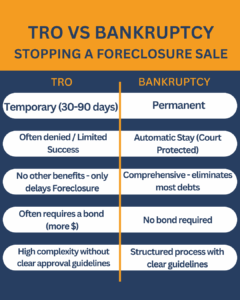 Why Bankruptcy Offers Superior Foreclosure Protection over a TRO in Texas
Why Bankruptcy Offers Superior Foreclosure Protection over a TRO in Texas
When facing foreclosure in Texas, homeowners often wonder whether to pursue a Temporary Restraining Order (TRO) vs bankruptcy as their defense strategy. While both options can temporarily halt foreclosure proceedings, the similarities end there. This comprehensive analysis reveals why bankruptcy consistently outperforms TROs as a foreclosure defense mechanism, offering homeowners in Texas and throughout Texas a more effective, comprehensive, and cost-efficient path to financial recovery.
Understanding the critical differences between TRO vs bankruptcy options can mean the difference between temporary relief and permanent debt resolution. As experienced Texas foreclosure attorneys, we’ve witnessed countless homeowners make costly decisions by choosing TROs over bankruptcy, only to find themselves back in foreclosure proceedings within months—often in worse financial positions than before.
Understanding TRO vs Bankruptcy: The Fundamental Differences
What is a Temporary Restraining Order (TRO) in Foreclosure?
A Temporary Restraining Order (TRO) represents an emergency legal remedy designed to halt foreclosure sales temporarily. In Texas’s non-judicial foreclosure system, homeowners can petition courts to stop foreclosure auctions by demonstrating irreparable harm. However, TROs face significant limitations that often make them ineffective long-term foreclosure solutions.
The TRO process requires homeowners to file emergency motions typically 24-48 hours before scheduled foreclosure sales. Courts evaluate whether allowing foreclosure would cause irreparable injury that monetary damages cannot remedy. Even when granted, TROs typically last only 30-90 days, providing merely temporary relief.
Bankruptcy as Comprehensive Foreclosure Defense
Bankruptcy, conversely, offers a structured federal legal process providing comprehensive debt relief and foreclosure protection. Unlike TROs, bankruptcy triggers an automatic stay that immediately halts foreclosure proceedings upon filing. This protection extends far beyond simple foreclosure delays, addressing underlying financial issues causing mortgage delinquency.
While Chapter 13 bankruptcy is more expensive in the long run, it not only allows homeowners to catch up on mortgage arrearages through 3-5 year repayment plans, it also eliminates unsecured debt and provides protection for the entire length of the bankruptcy.
Cost Analysis: TRO vs Bankruptcy Financial Implications
TRO Costs and Hidden Expenses
TRO filing represents a significant financial gamble with limited success potential. Texas attorneys typically charge $1,500-$2,000 for TRO representation, with costs due 48 hours before foreclosure sales. Additionally, courts often require surety bonds protecting lenders from economic harm during TRO periods.
These bonds can cost thousands more, especially when courts doubt TRO claims’ merit. Most critically, TRO costs are non-refundable regardless of outcome. When TROs fail—which happens frequently—homeowners lose substantial attorney fees while gaining no debt relief or permanent foreclosure protection.
Bankruptcy: Comprehensive Value Proposition
Bankruptcy costs provide exponentially greater value than TRO expenses. Chapter 13 costs are more expensive and depend on the filing district and local guidelines, but provide years of foreclosure protection plus the added benefit of actually curing the mortgage arrears and discharging unsecured debt as well. Unlike TRO costs that provide only temporary delays, bankruptcy expenses deliver permanent debt relief.
TRO Success Rate Limitations
TRO success rates remain disappointingly low across Texas foreclosure cases. Multiple factors contribute to frequent TRO denials, including stringent legal standards requiring proof of irreparable harm and procedural defects in foreclosure proceedings.
Courts increasingly scrutinize TRO applications, recognizing that many homeowners file them simply to delay inevitable foreclosures without legitimate legal grounds. Even when initially granted, lenders frequently file successful motions to lift TRO stays, resuming foreclosure proceedings within weeks.
Bankruptcy: Guaranteed Automatic Stay Protection
Bankruptcy provides guaranteed foreclosure protection through the automatic stay provision. Unlike TRO applications subject to judicial discretion, bankruptcy automatic stays activate immediately upon petition filing. This protection remains effective throughout bankruptcy proceedings, typically lasting 4-6 months in Chapter 7 or 3-5 years in Chapter 13.
The automatic stay prevents all collection activities, including foreclosure sales, wage garnishments, creditor harassment, and utility disconnections. This comprehensive protection allows debtors to address financial problems systematically rather than fighting individual collection actions.
Timeline Considerations: When to Choose TRO vs Bankruptcy
TRO Timeline Constraints
TRO timing requirements create significant disadvantages for homeowners facing foreclosure. Texas law requires TRO applications 24-48 hours before scheduled foreclosure sales, leaving minimal preparation time. This compressed timeline often results in rushed legal arguments and incomplete documentation supporting TRO claims.
Furthermore, TRO duration limitations mean homeowners must develop permanent solutions within 30-90 day windows. Without addressing underlying financial problems, most homeowners cannot cure substantial mortgage arrearages during brief TRO periods, making foreclosure resumption inevitable.
Bankruptcy: Flexible Filing Timeline
Bankruptcy offers superior timeline flexibility compared to TRO constraints. Homeowners can file bankruptcy anytime before foreclosure sales complete, even on auction days. This flexibility allows thorough preparation of bankruptcy petitions and supporting documentation.
More importantly, bankruptcy addresses root causes of foreclosure through comprehensive debt relief. Chapter 13 provides 3-5 years to cure mortgage arrearages while eliminating competing unsecured financial obligations, freeing income for mortgage payments or facilitating orderly property disposition.
Legal Complexity: TRO vs Bankruptcy Procedural Requirements
TRO Legal Standards and Challenges
TRO applications face complex legal hurdles often insurmountable for homeowners with legitimate financial hardships. Courts require proof of irreparable injury, likelihood of success on underlying claims, and balance of hardships favoring debtors.
These standards prove particularly challenging in Texas foreclosure cases where non-judicial foreclosure procedures favor lender interests. Homeowners must identify specific procedural violations or substantive legal defenses supporting TRO claims. Without clear mortgage contract breaches or foreclosure notice defects, TRO applications typically fail.
Bankruptcy: Structured Federal Process
Bankruptcy follows established federal procedures providing clear guidance for debtors and attorneys. The Bankruptcy Code creates uniform national standards governing debt discharge, asset protection, and creditor treatment. This structured framework eliminates uncertainty surrounding TRO application outcomes.
Additionally, bankruptcy exemptions protect essential assets including homesteads, vehicles, retirement accounts, and personal property. These protections ensure debtors maintain basic living standards while addressing financial problems through court-supervised processes.
Long-Term Financial Recovery: TRO vs Bankruptcy Outcomes
TRO: No Debt Relief or Financial Recovery
TROs provide zero debt relief beyond temporary foreclosure delays. Homeowners remain liable for all original debts plus accumulating interest, late fees, and attorney costs. When TROs expire—typically within 30-90 days—debtors face identical financial problems that caused initial foreclosure proceedings.
This lack of comprehensive relief often worsens debtor financial positions. Additional TRO legal fees reduce available funds for mortgage payments or other essential expenses. Homeowners may exhaust remaining financial resources pursuing ineffective TRO relief while ignoring superior bankruptcy alternatives.
Bankruptcy: Comprehensive Financial Fresh Start
Bankruptcy provides genuine financial recovery through debt elimination and restructuring. Chapter 13 mortgage arrears repayment plans provide structured debt management over 3-5 years while maintaining homeownership.
Beyond immediate debt relief, bankruptcy offers educational resources including mandatory financial management courses helping debtors develop sustainable budgeting practices. This comprehensive approach addresses both immediate financial crises and underlying money management issues contributing to foreclosure situations.
Texas Foreclosure Law: How TRO vs Bankruptcy Interact with State Procedures
Texas Hybrid Foreclosure System
Texas operates a hybrid foreclosure system favoring lender interests while providing limited homeowner protections. Most foreclosures proceed non-judicially under deed of trust power of sale clauses, allowing lenders to foreclose without court supervision.
This system creates challenges for TRO applications because courts defer to contractual foreclosure rights unless homeowners prove substantial procedural violations. Texas’s lender-friendly environment makes successful TRO applications particularly difficult compared to other states.
Federal Bankruptcy Supremacy
Bankruptcy law preempts state foreclosure procedures through federal supremacy doctrine. When debtors file bankruptcy petitions, automatic stays immediately halt all state collection proceedings regardless of Texas foreclosure statutes.
This federal protection supersedes Texas foreclosure laws, providing uniform relief standards nationwide. Homeowners cannot be denied automatic stay protection based on state-specific foreclosure procedures or judicial preferences favoring lender interests.
Making the Strategic Choice: When Bankruptcy Outperforms TRO
Ideal TRO Candidates (Rare Scenarios)
TROs may benefit only limited homeowner situations where specific legal violations occurred and permanent financing solutions exist. Examples include foreclosures proceeding without proper notice, lender failures to comply with loss mitigation requirements, or pending property sales requiring brief delays.
However, these scenarios represent less than 5% of foreclosure cases. Most homeowners facing foreclosure lack the specific legal defenses necessary for successful TRO applications while struggling with broader financial problems requiring comprehensive debt relief.
Bankruptcy: The Superior Choice for Most Homeowners
Bankruptcy serves 95% of foreclosure situations better than TROs because it addresses underlying financial distress causing mortgage delinquency. Rather than temporarily delaying inevitable foreclosures, bankruptcy provides permanent debt solutions enabling genuine financial recovery.
Chapter 13 bankruptcy particularly benefits homeowners wanting to retain property while curing mortgage arrearages. The 3-5 year repayment period provides realistic timeframes for addressing substantial delinquencies while managing other debts through court-supervised plans.
Conclusion: Why Bankruptcy Consistently Wins the TRO vs Bankruptcy Comparison
The TRO vs bankruptcy analysis clearly demonstrates bankruptcy’s superior effectiveness for foreclosure defense. While TROs offer only temporary, expensive, and uncertain relief, bankruptcy provides comprehensive, affordable, and guaranteed protection through the automatic stay and debt discharge process.
For Texas homeowners facing foreclosure, the choice between TRO vs bankruptcy should heavily favor bankruptcy except in rare cases involving clear procedural violations and available permanent financing solutions. Bankruptcy’s federal protections, structured procedures, and comprehensive debt relief create sustainable paths to financial recovery that TROs simply cannot match.
Rather than gambling on expensive, time-sensitive TRO applications with poor success rates, homeowners should consult qualified bankruptcy attorneys to explore Chapter 7 and Chapter 13 alternatives. These federal remedies provide the genuine foreclosure protection and debt relief necessary for meaningful financial fresh starts.
Contact our experienced Texas bankruptcy attorneys today to discuss how bankruptcy can provide superior foreclosure protection compared to risky TRO applications. Don’t waste precious time and money on temporary solutions when comprehensive bankruptcy relief awaits.


